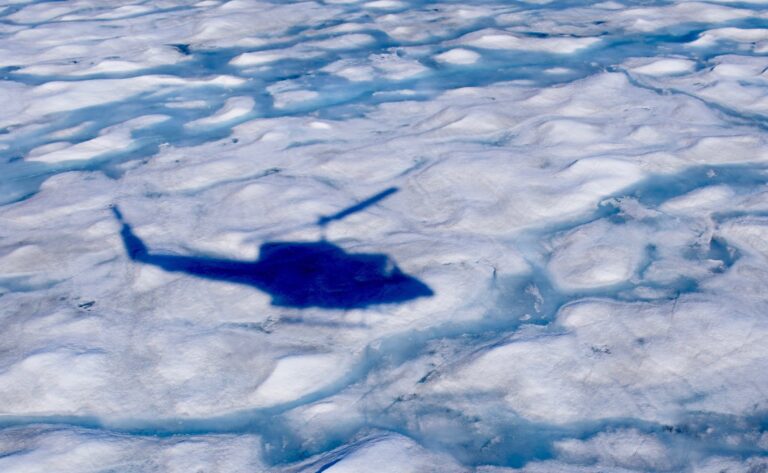UCI researchers identify primary causes of Greenland’s rapid ice sheet surface melt

A helicopter flight over Greenland enabled UCI Earth system scientists to observe melt ponds. By gathering data from a network of weather instruments placed around the massive island, the researchers determined that surface melting of its ice sheet is coming mainly from the steady, day-to-day effect of wind- and solar-driven heat. Wenshan Wang / UCI
Intense, wide-spread melting events in Greenland, such as one in July 2012 that touched nearly every part of the massive island’s frozen slab, are catastrophic, but they still account for only a small portion of the total deterioration of the ice sheet, according to researchers at the University of California, Irvine.
In a recently published study in the American Geophysical Union journal Geophysical Research Letters, UCI Earth system scientists claim that the real culprit is a more gradual, day-to-day process by which wind- and solar-driven heat is chewing away at the ice, helping to make Greenland our planet’s largest contributor to global sea level rise.
“The prevailing hypothesis has been that rapid melting events – exacerbated by the greenhouse effect of clouds – are the cause of a significant portion of the ice mass loss in Greenland,” said senior co-author Charlie Zender, UCI professor of Earth system science. “However, we found that such extreme episodes are to blame for only two percent of the total surface melt since 2007.”
Using data from an international network of long-term automatic weather stations positioned in ice loss-prone regions throughout Greenland, the researchers conducted the most comprehensive analysis to-date of the physical processes that cause surface ice melt.
They found that 31 percent of the thawing results from wind-driven turbulence warming the ice, what the scientists label as “sensible heat exchange” in the study. Another 28 percent of the melting comes from solar radiation which reaches the ice surface during the clear sky periods that coincide with the local air flows known as katabatic winds.
The contribution of katabatic winds to the steady decline of polar ice is now better understood, according to the researchers. In Greenland, sunlight reflects off the snow and ice, heating the air just above. Katabatic winds come along to mix up the atmosphere, driving warm air back to the ground.“Katabatic winds are gravity-driven downslope air flows that can be quite strong and create a lot of turbulence,” said lead author Wenshan Wang, a UCI graduate student researcher in Earth system science. “These winds are like a blender that grabs warmer air from aloft and brings it down to the surface where it displaces cold air and melts the ice.”
Wang also said that katabatic winds are often associated with clear skies.
“Because of this, what we now often see is a concurrent effect of ample shortwave solar radiation combined with warm air circulating around the surface,” she said.
Zender said that the most aggressive melt regions in Greenland lie along steep ice sheet margins where the katabatic wind effect is strongest. He added that on Greenland’s flatter inland regions, katabatic winds also are the dominant form of air flow, but there is less of a melting impact than in sloped terrain. In these areas, melting is more likely to come from long-wave radiative heating from liquid-containing clouds – a direct signal of climate change.
“Still, solar and sensible heat, which primarily occurs during periods featuring katabatic winds, will continue to dominate surface mass loss of the Greenland ice sheet going forward,” said Zender.
Joining Wang and Zender on this project, which was supported by the U.S. Department of Energy, NASA and the National Science Foundation, were Dirk van As and Robert Fausto from the Geological Survey of Denmark and Greenland, and Matthew Laffin, a UCI graduate student in the Department of Earth System Science.
About the University of California, Irvine: Founded in 1965, UCI is the youngest member of the prestigious Association of American Universities and is ranked among the nation’s top 10 public universities by U.S. News & World Report. The campus has produced three Nobel laureates and is known for its academic achievement, premier research, innovation and anteater mascot. Led by Chancellor Howard Gillman, UCI has more than 36,000 students and offers 224 degree programs. It’s located in one of the world’s safest and most economically vibrant communities and is Orange County’s second-largest employer, contributing $7 billion annually to the local economy and $8 billion statewide. For more on UCI, visit www.uci.edu.
Media access: Radio programs/stations may, for a fee, use an on-campus ISDN line to interview UCI faculty and experts, subject to availability and university approval. For more UCI news, visit news.uci.edu. Additional resources for journalists may be found at communications.uci.edu/for-journalists.
